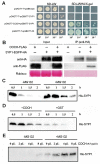SYMMETRIC PETALS 1 Encodes an ALOG Domain Protein that Controls Floral Organ Internal Asymmetry in Pea (Pisum sativum L.)
- PMID: 32517095
- PMCID: PMC7313044
- DOI: 10.3390/ijms21114060
SYMMETRIC PETALS 1 Encodes an ALOG Domain Protein that Controls Floral Organ Internal Asymmetry in Pea (Pisum sativum L.)
Abstract
In contrast to typical radially symmetrical flowers, zygomorphic flowers, such as those produced by pea (Pisum sativum L.), have bilateral symmetry, manifesting dorsoventral (DV) and organ internal (IN) asymmetry. However, the molecular mechanism controlling IN asymmetry remains largely unclear. Here, we used a comparative mapping approach to clone SYMMETRIC PETALS 1 (SYP1), which encodes a key regulator of floral organ internal asymmetry. Phylogenetic analysis showed that SYP1 is an ortholog of Arabidopsis thaliana LIGHT-DEPENDENT SHORT HYPOCOTYL 3 (LSH3), an ALOG (Arabidopsis LSH1 and Oryza G1) family transcription factor. Genetic analysis and physical interaction assays showed that COCHLEATA (COCH, Arabidopsis BLADE-ON-PETIOLE ortholog), a known regulator of compound leaf and nodule identity in pea, is involved in organ internal asymmetry and interacts with SYP1. COCH and SYP1 had similar expression patterns and COCH and SYP1 target to the nucleus. Furthermore, our results suggested that COCH represses the 26S proteasome-mediated degradation of SYP1 and regulates its abundance. Our study suggested that the COCH-SYP1 module plays a pivotal role in floral organ internal asymmetry development in legumes.
Keywords: ALOG family; COCHLEATA; IN asymmetry; LSH3; Pisum sativum; SYMMETRIC PETALS 1.
Conflict of interest statement
The authors declare no conflict of interest.
Figures






References
MeSH terms
Substances
Grants and funding
LinkOut - more resources
Full Text Sources
Miscellaneous

